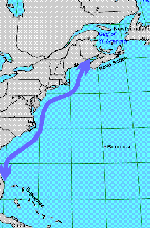 |
 |
 |
 |
 |
 |
 |
Right Whale Migration Update: March 14, 2001
Today's Report Includes:
- Greetings from the Stellwagen Bank National Marine Sanctuary
- Bonanza! Ten Mothers With Calves
- First Confirmed Vessel-Struck Whale of 2001
- Try This! Experiment With Adaptations
- Word Problems and Analogies: Challenge Questions #8 and #9
- Discussion of Challenge Question #6
- A Long Way to Travel! Discussion of Challenge Question #7
Greetings from the Stellwagen Bank National Marine Sanctuary.
Bonanza! Ten Mothers With Calves
"There's never been a week like that since the inception of surveys in the calving ground?" That is one of the exclamations made last week by Chris Slay from the NE Aquarium's Right Whale Research Group. "On a single flight, we sighted 10 different mothers with calves, all within a few miles of each other. The sighting area, off of Amelia Island, appears to be where the animals 'bunch-up' upon arriving in the calving ground, before stringing out along the Florida coast. A similar massing seems to occur at the end of season, before most of the animals head north along the eastern seaboard.
First Confirmed Vessel-Struck Whale of 2001
The survey crews have been watching Bolo, whale #1160 this season. Sighted many times since December 8. On January 16, they sighted her with a calf. An aerial crew from the University of North Carolina at Wilmington reported locating Bolo off of Hilton Head Island, SC and reported that a boat had struck her. This was based on the observation of gruesome propeller cuts tracking across 10'-12' of her back. The injury must hav occurred between our last sighting on January 29 and February 16 when the UNCW reported seeing her.
Lisa Conger, leader of the offshore (OSS) aerial survey team (a unit of the Florida Fish and Wildlife Conservation Commission) saw Bolo next on March 1. Lisa had a relatively good look at the cuts and reported that the injury doesn't appear life threatening. The lacerations went into the white blubber layer but not too deeply. None of the cuts appeared deep enough to effect muscle tissue. Had the calf taken this hit, it would be dead. I think the word Conger used was "lucky".
Clues From Whales: Keen Sense of Hearing May Save Them
Chris continued with his report with two incidents that give us some information about whales' responding to ships.
"No doubt, there's some guesswork involved in understanding boat/whale encounters. It's hard to know how whales react to oncoming vessels. We have contacted ships from our aircraft on several occasions this season when we perceived there was a potential for collision. While we might observe a vessel making course or speed adjustments, it's difficult to ascertain what the whales hear beneath the surface and how they might attempt to avoid being run over. In one case, when the target ship changed course, the whales appeared to respond, possibly to a change in the acoustic signature of the vessel changing course. The mother and calf turned and headed WSW.
"Two days earlier, the EWS team began circling a mother and calf right whale for photos and noted a submarine approaching from the southeast. The submarine was headed NW, directly to the whale's position. When the submarine was approximately 200 meters from the pair, the whales dove and apparently changed direction, almost 180 degrees. When they resurfaced, less than a minute later, they were approximately 300 meters off the starboard beam of the submarine, heading NE."
Cooperation is Positive: Pair Seen Returning North
These are really positive reports from the calving grounds this year, as compared to last year when only one calf was seen. It's also very encouraging that other marine traffic, including work boats and the US Navy, are making the effort to avoid these whales to prevent collisions.
We have also received word that a dredge vessel located off Cape Fear, North Carolina (off the Frying Pan Shoals east of the mouth of the Cape Fear River) spotted a mother-calf pair on March 12. This may be a pair on their journey north. Can you find this location on your map?
Try This! Experiment With Adaptations
 |
After doing the "Staying Warm" experiment, give this question a try:
Challenge Question #8:
"How is a mitten like a whale? Be as descriptive with your answer as possible."
And while you are still thinking about comparing concepts, try this:
Challenge Question #9:
"Complete these analogies:
fluke:tail :: baleen : ___________, AND
monarch:Mexico :: right whale: ___________"
(To respond to these questions, please follow
the instructions below.)
Discussion of Challenge Question #6
"Locate the position of the whales at 41.93N and -70.23W. Then look for landmarks within a 7.1 nautical mile radius (a nautical mile is 6080 feet verses a mile is 5280 feet). Can you list some landmarks?"
This location inside Cape Cod Bay is west of the town of Wellfleet, and south of Provincetown, MA.
A Long Way to Travel! Discussion of Challenge Question #7
"How long would it take a Right Whale to travel from Cape Canaveral, Florida to Provincetown, Cape Cod, Mass. if they traveled at the rate of 25 nautical miles per day?"
If you used the distance calculator on the WWW you'll find that the mileage as the crow flies is 1,109 miles or 964 nautical miles (a nautical mile is 1.15 miles). The answer would be 38.5 days.
How to Respond to Today's Right Whale Challenge Question:
IMPORTANT: Answer only ONE question in each e-mail message.
1. Address an E-mail message to: jn-challenge-rwhale@learner.org
2. In the Subject Line of your message write: Challenge Question #8 (or #9).
3. In the body of the EACH message, give your answer to ONE question above.
The Next Right Whale Migration Update will Be Posted on March 28, 2001
Copyright 2001 Journey North. All Rights Reserved. Please send all questions, comments, and suggestions to our feedback form
 |
 |
 |
 |
 |
 |

